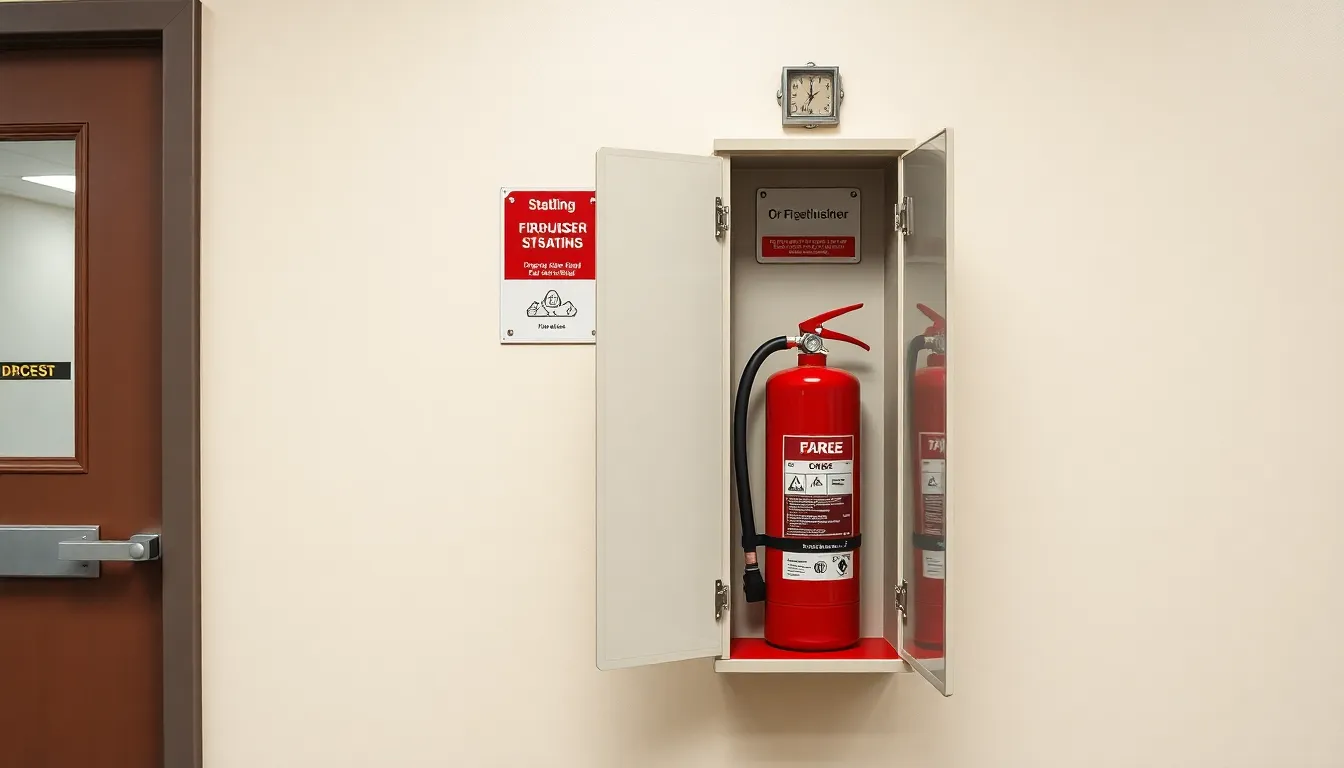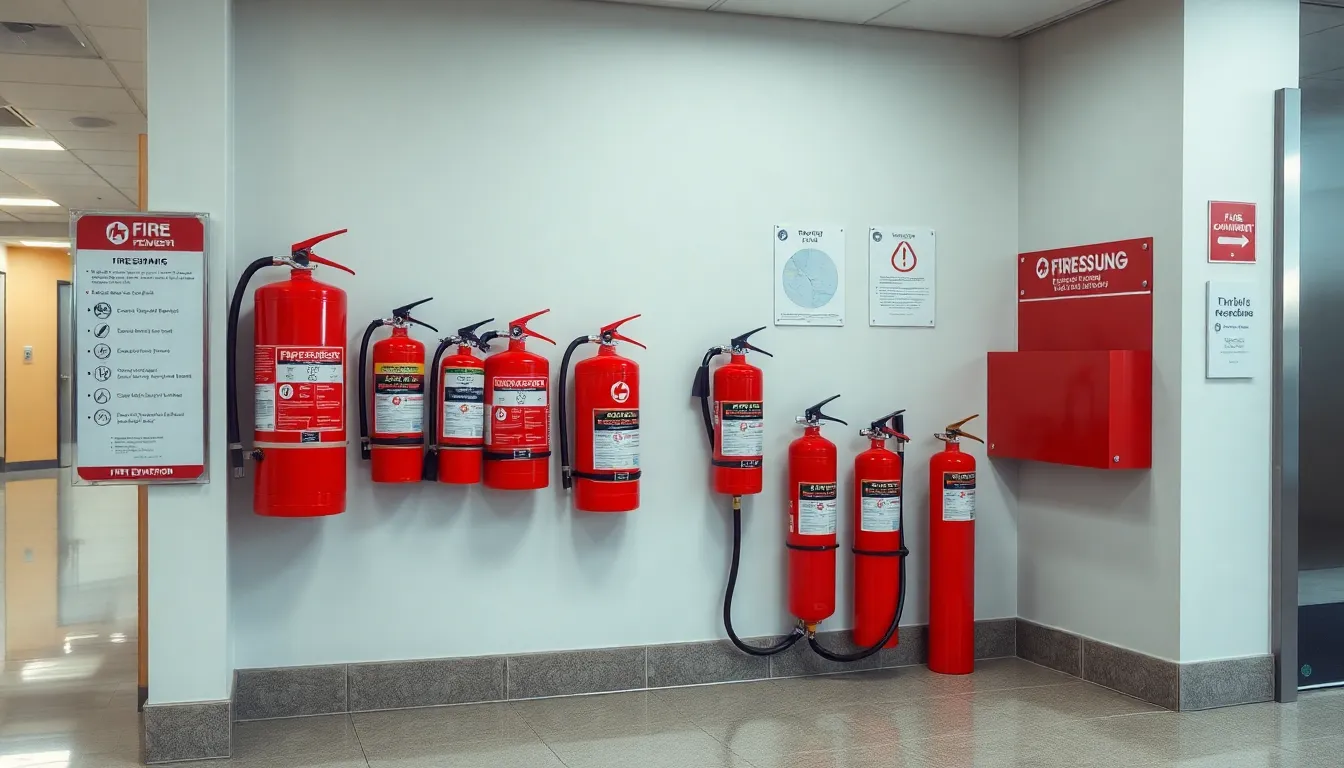In a world where fire safety often takes a backseat to everyday hustle, the fire extinguisher station stands as a hero in disguise. Imagine a superhero without a cape—just a sleek red canister waiting to battle flames and save the day. These stations are strategically placed to ensure that when the heat is on, help is just a quick dash away.
Table of Contents
ToggleOverview of Fire Extinguisher Stations
Fire extinguisher stations serve as critical components in fire safety plans. Every station contains one or more extinguishers tailored for specific types of fires, such as Class A for ordinary combustibles, Class B for flammable liquids, Class C for electrical fires, and Class K for kitchen-related fires. Their accessible location enhances quick response during emergencies, preventing minor fires from escalating.
Proper placement occurs in easily identifiable areas. These locations should ensure visibility and accessibility, ideally within a 75-foot radius from any point in a building. Compliance with National Fire Protection Association (NFPA) standards governs this placement, ensuring safety regulations align with local codes.
Routine inspections safeguard the functionality of extinguishers. Fire safety personnel conduct checks monthly, verifying pressure gauges and overall condition. Any extinguisher found to be unserviceable requires immediate replacement or repair to maintain safety.
Training plays an essential role in effective utilization. Employees should receive fire safety training, emphasizing how to operate extinguishers properly. Regular drills simulate emergency situations, which prepares personnel to respond quickly and efficiently when needed.
The integration of signage enhances awareness. Clear markings and instructions on the extinguishers guide users during critical moments, reinforcing their role in fire safety. Visible stations deter complacency and encourage proactive responses by all occupants within the area.
Vigilance in maintaining and effectively using fire extinguisher stations elevates overall safety in environments vulnerable to fire hazards.
Importance of Fire Extinguisher Stations
Fire extinguisher stations play a vital role in enhancing fire safety measures. Their strategic installation and maintenance can make a crucial difference in emergency situations.
Legal Requirements and Standards
Legal standards govern the placement and maintenance of fire extinguisher stations. The National Fire Protection Association (NFPA) outlines specific guidelines for accessibility, visibility, and types of extinguishers required. Stations should be located within 75 feet of any point in a building to ensure quick access. Maintenance schedules also exist, with inspections mandated at least once a month to verify that extinguishers are fully charged and in good condition. Following these regulations not only complies with the law but also provides critical protection to occupants.
Safety Benefits
Safety benefits of fire extinguisher stations are significant. Accessible extinguishers allow for immediate response to small fires, minimizing damage and preventing escalation. Each type of extinguisher suits specific fire classes, creating effective suppression of different materials. Proper training on usage further equips personnel to act swiftly and efficiently. Regular fire drills reinforce these skills, ensuring that employees are prepared when an emergency occurs. Clear signage enhances user awareness, directing individuals to the nearest extinguishers during crises. Together, these elements foster a safer environment, reducing risks associated with fire hazards.
Types of Fire Extinguisher Stations
Fire extinguisher stations come in various types, ensuring readiness for different fire scenarios. Two primary types exist: portable and fixed stations.
Portable vs. Fixed Stations
Portable stations provide flexibility, allowing easy relocation to suit changing needs. These stations typically feature lightweight extinguishers that can be transported for convenience. Fixed stations, on the other hand, consist of wall-mounted units that maintain a permanent presence within a facility. They ensure consistent access in emergencies but can limit movement and adaptability. Portable options work well in dynamic environments, while fixed stations suit more structured layouts.
Design and Layout Options
Design influences the effectiveness of fire extinguisher stations. Various design elements exist, including signage, cabinet types, and extinguisher placements. Visual clarity is essential; proper signage enhances visibility and directs users quickly. Cabinets come in different materials, such as steel or plastic, catering to environmental conditions. Strategic layout aligns with the National Fire Protection Association guidelines, promoting access within a 75-foot radius of any building area. Overall, a thoughtful design ensures that extinguishers are not only visible but also easy to access in moments of crisis.
Best Practices for Installation and Maintenance
Installation and maintenance of fire extinguisher stations require strict adherence to guidelines. Following best practices ensures effectiveness in emergencies.
Regular Inspection Protocols
Establishing inspection protocols is vital for fire extinguisher stations. Inspections should occur monthly to confirm each extinguisher’s proper charge and operational status. Hefty fines can result from non-compliance with the National Fire Protection Association (NFPA) guidelines. Qualified personnel must conduct these inspections, using checklists to document each extinguisher’s condition. Visual inspections should include assessments of pressure gauges, physical damage, and accessibility. Accurate records of inspections aid in compliance and accountability. Maintaining this routine promotes safety and readiness in fire situations.
Training and Accessibility
Training employees fosters confidence in using fire extinguishers effectively. Regular training sessions should cover proper operation techniques and emergency response strategies. Moreover, accessibility plays a crucial role; extinguishers must always be within a 75-foot radius of any location in a building. Signage enhances visibility, directing individuals to the nearest extinguisher during a crisis. Familiarizing staff with fire safety equipment ensures swift engagement when needed. Prioritizing comprehensive training and clear accessibility significantly improves overall fire safety preparedness.
Conclusion
Fire extinguisher stations play a vital role in ensuring safety in both residential and commercial settings. Their strategic placement and proper maintenance not only comply with legal standards but also provide essential support during emergencies. By investing in training and regular inspections, organizations can empower their personnel to respond effectively to fire incidents.
The thoughtful design and clear signage of these stations further enhance their accessibility and usability. Prioritizing fire safety through well-implemented extinguisher stations minimizes risks and protects lives and property. Ultimately, a proactive approach to fire safety fosters a culture of preparedness and resilience in the face of potential fire hazards.








